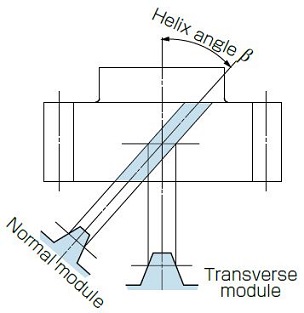What is the helix angle of gears?
The helix angle (β) of a gear is the angle formed by the helical line of the tooth trace and the generatrix of the cylinder on a cylinder such as a pitch cylinder. In the case of spiral bevel gears, it is the angle formed by the tooth trace and the generatrix of the pitch cone.
The helix angle is an important factor in the specifications of helical gears, spiral bevel gears, worm gears, and other gears.
In helical gears with parallel axes, the helix angles of the meshing pair of gears are equal. However, there are two types of tooth profiles for helical gears: transverse module and normal module, and even if the helix angles of both gears are the same, they cannot mesh if the tooth profiles are different.
The larger the value of the helix angle is (and the wider the tooth width), the higher the overlap ratio, which affects the magnitude of noise and vibration of the gears. In addition, the larger the value of the helix angle, the greater the axial thrust force on the shaft (Since they do not have a helix angle, spur gears have no thrust force).

相关链接 - 齿轮的螺旋角


